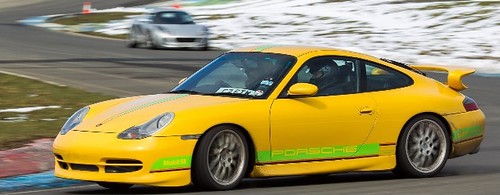Serious question - what's the point in H&T in a rear wheel drive car (I know nothing about FWD/4WD)?
To answer my own question, the point is that it allows you to reduce engine braking during aggressive down shift - typically these will be occurring on track, braking from high speed straight down to hairpin or similar situations where you jump from, say, 4th to 2nd. As you brake harder and harder to compress the braking zone as far as is possible you reach the point where the down shift to 2nd adds so much extra (engine) braking to the rear wheels that they begin to lock (especially a problem in the wet, but the chirrup of hot rear tyres on down shift is a sure sign you are approaching the limit in the dry). We all know that a locked wheel has less grip than a rotating one, hence the rear starts to step out (it wants to overtake the front) on the way into the corner - a bit like pulling on the handbrake would.
It is my opinion that it is only when you are reaching this point that H&T has any sensible application. You can do all the blipping and whatever else you want on the road but it ought to be pointless - there is no way you should be so close to the limits of rear traction on the road so as to have to do this (just drive a lot slower).
So whilst Mass is right that you ought to be able the apply H&T at all sorts of brake pressures the reality is that it is mostly only relevant at near max pressure. Thus you ought to learn to do it under heavy braking and later you can play around with it at various pressures, for whatever that might be worth. One situation where it might make sense under less pressure is on a wet track; here you will have an extended braking zone but less grip to play with - you cannot use maximum brake pressure because that will lock the fronts, and you cannot just chuck it down a gear because at the limit that locks the rears; so you need to H&T under less pressure (or, as I do, just use a slightly longer braking zone in the wet

- I don't compete so no odds to me).
Those that know me will know I am no ballet dancer and yet I can do it, so it is mostly just a matter of forcing your foot/ankle/knee/hip to do the unnatural rotation.
Relatively straight forward to practice in neutral and stationary (somewhere that won't annoy the neighbours!).
The key is that you need to lift your heel whilst pressing with the ball of the foot - that should be possible for anyone - the knee must bend to achieve this. Once your knee is moving up and down whilst you have brake pressure applied you can move to rotating the heel whilst raised. This will cause your right knee to swivel across to your left knee as the hip joint rotates. Collect throttle with the heel or ankle or shoe. Drop the knee to press throttle - keep pressure on ball of foot at all times. To return to no throttle you don't need to do the reverse - you can just swivel off the pedal.
I tend to mash the throttle during this procedure as mostly you should be changing down into high revs - if you hit 5-6K RPM reliably that tends to be close enough to eliminate the rear lock up problem - but of course if you're trying to do this on the way to Tesco, that isn't going to be right

Please don't be tempted to cover both pedals and rock the foot. No doubt somebody will tell me Fangio or Senna did it this way, but for mere mortals it is a recipe for disaster - it is easy to overwhelm the front grip this way and develop comedy understeer (rotate steering lock to lock and car ploughs on straight). If you don't happen to lock the fronts you will still end up extending your braking zone by accelerating and braking at the same time.
PartTimer: when you say you couldn't get the timing right, what do you mean? That you would press the throttle before disengaging clutch/still press throttle after engaging clutch? You might have to stop thinking about it and let it come naturally (perhaps by doing it badly until your brain learns the right timing by itself).
Cheers,
Robin

